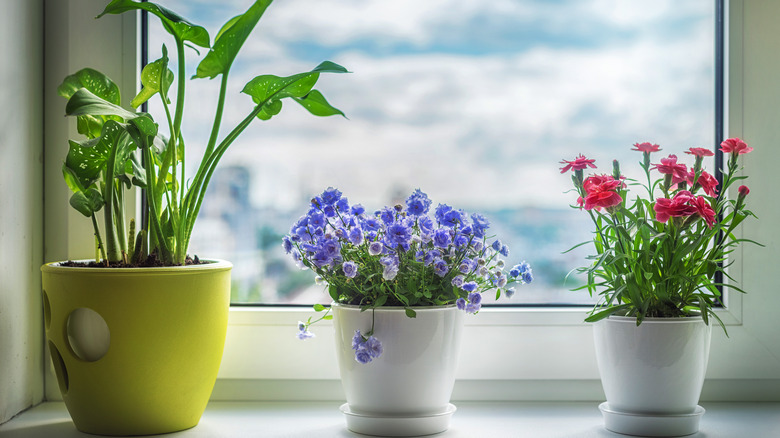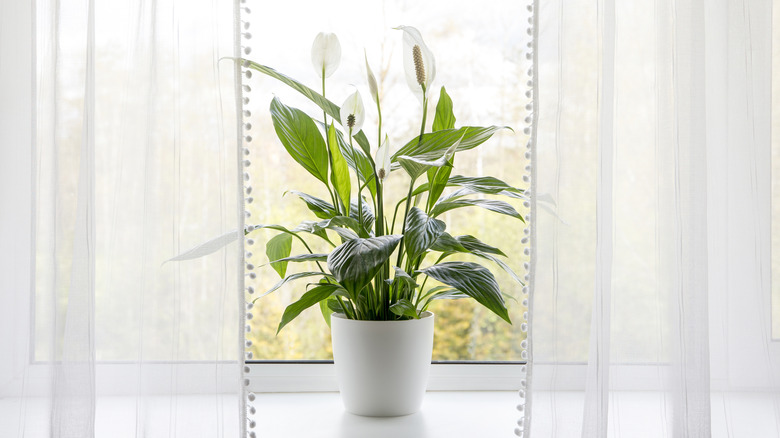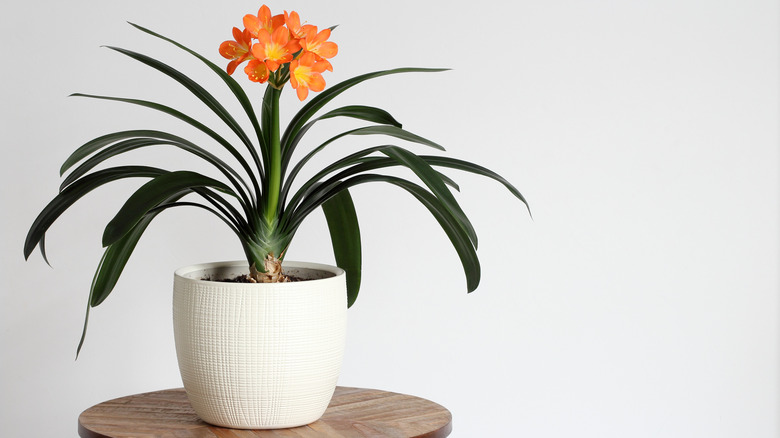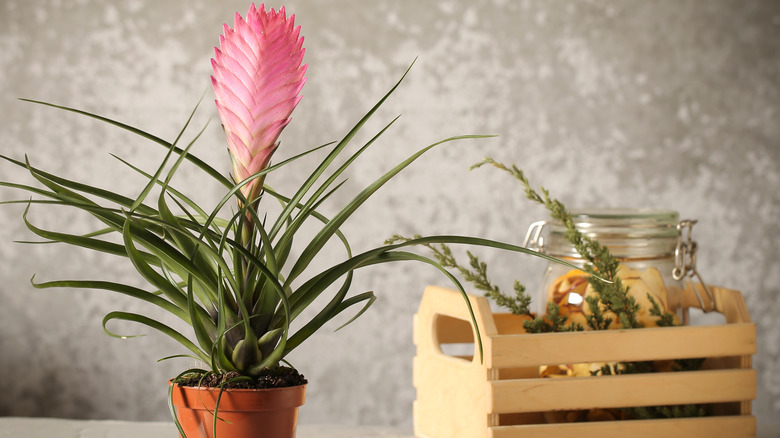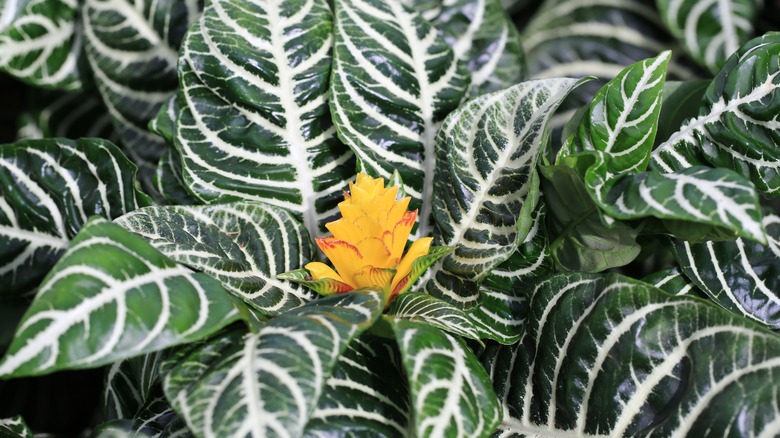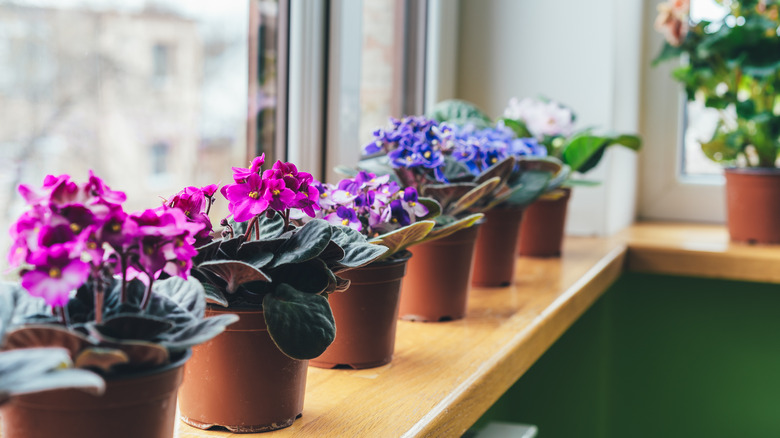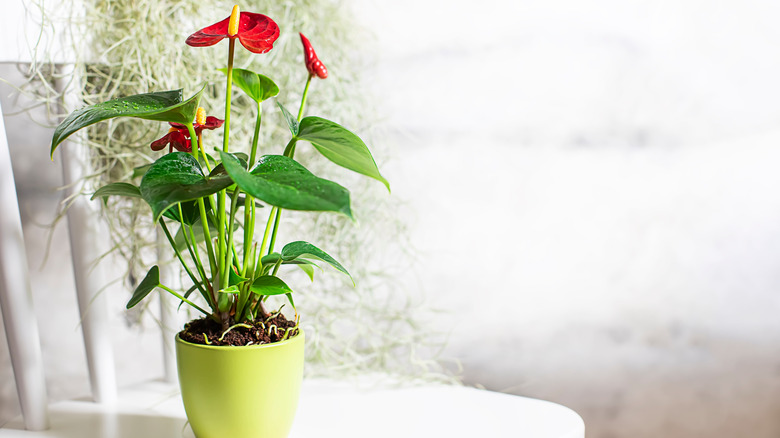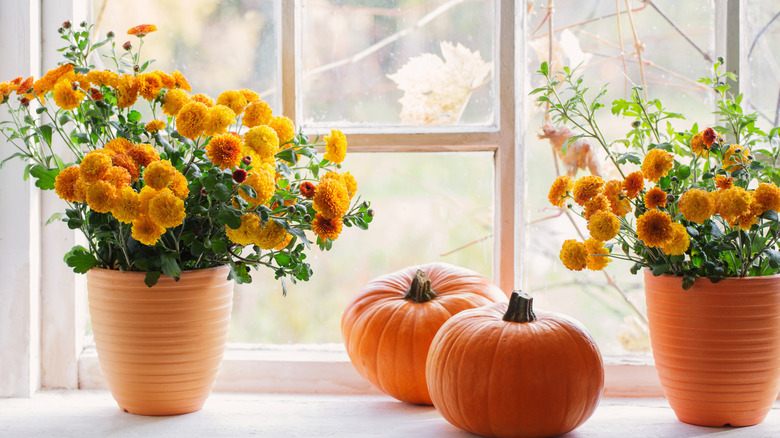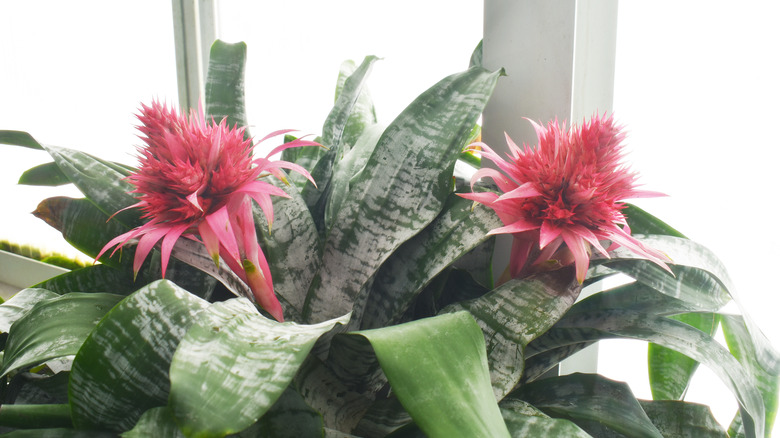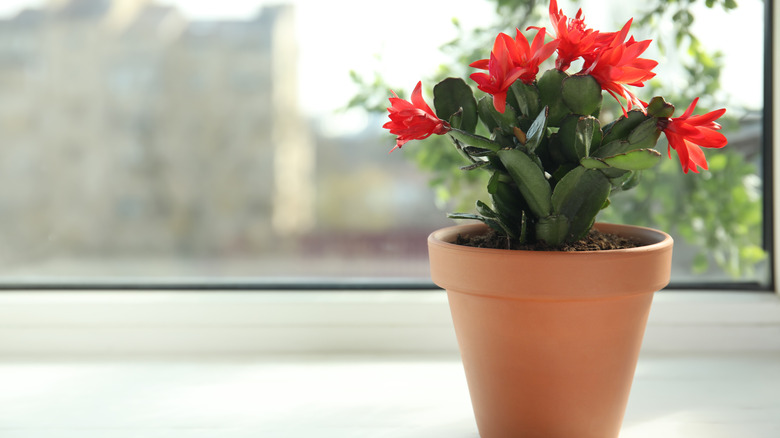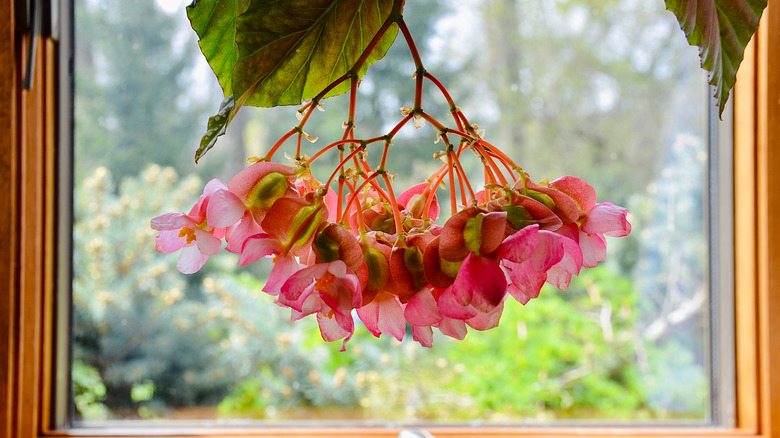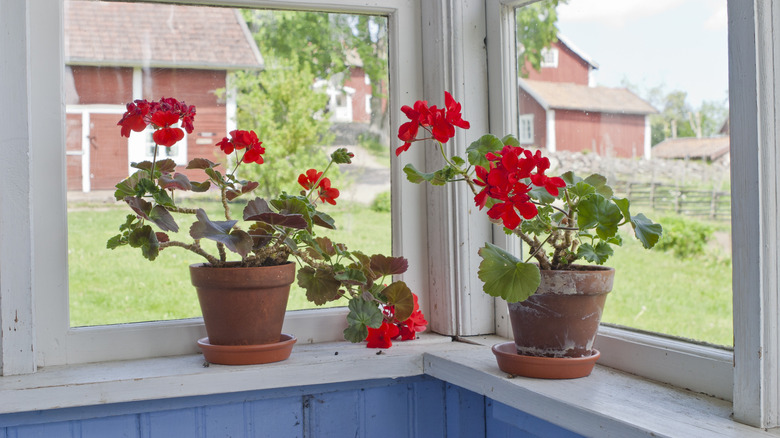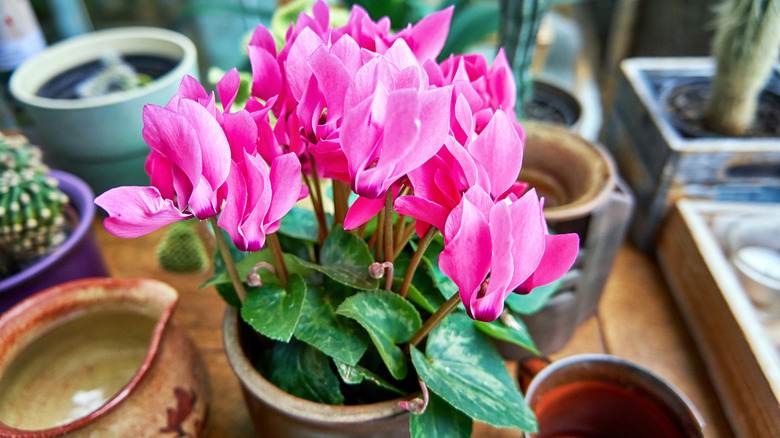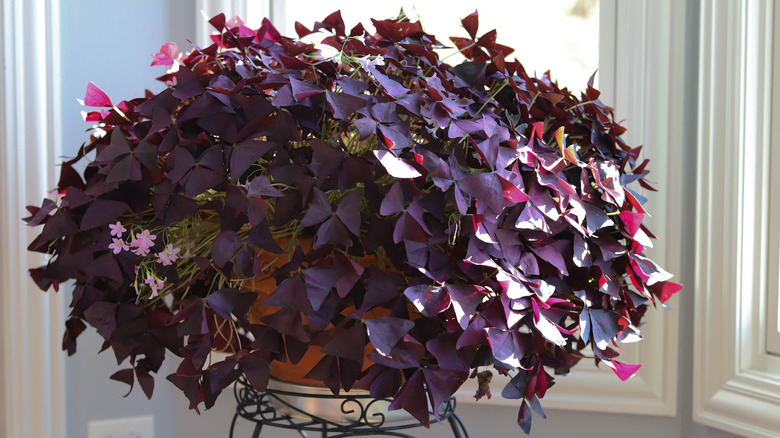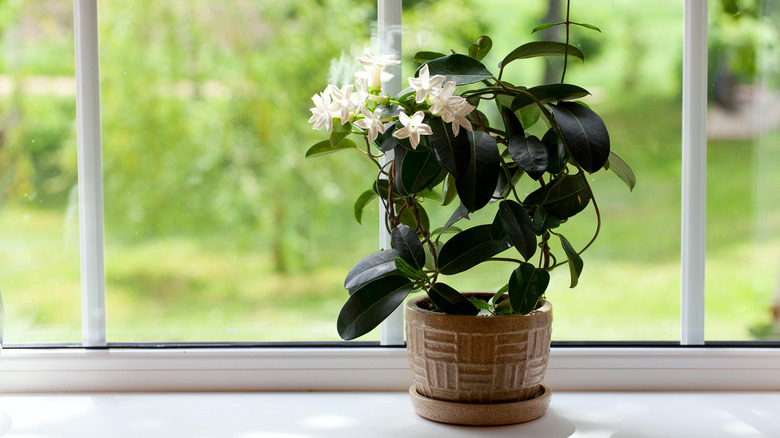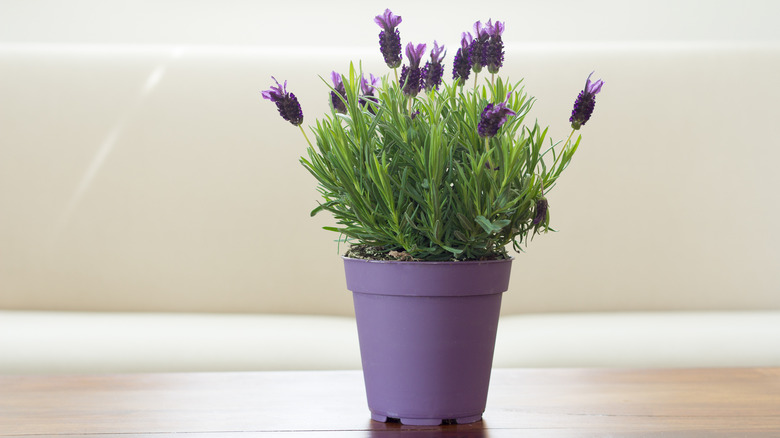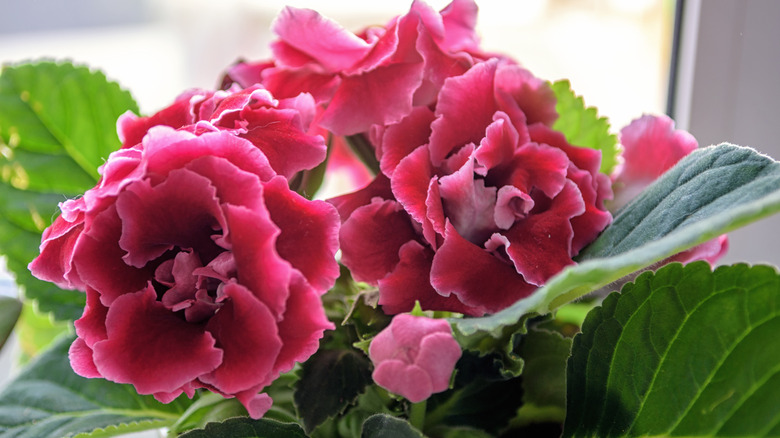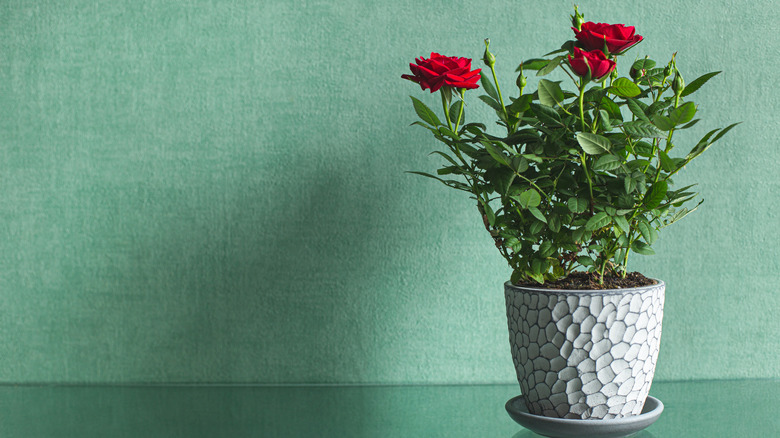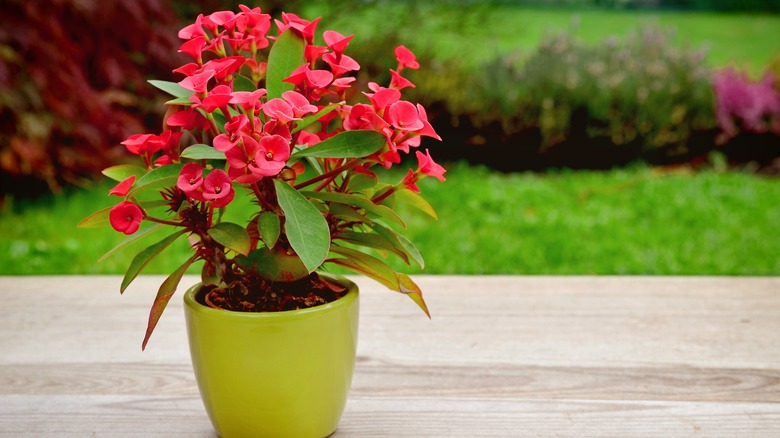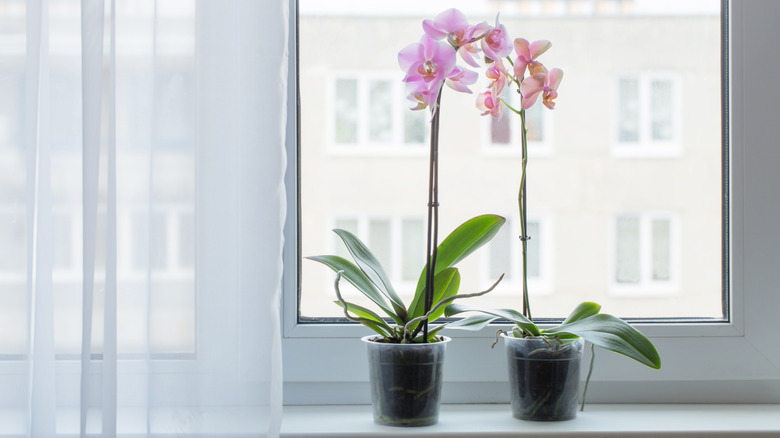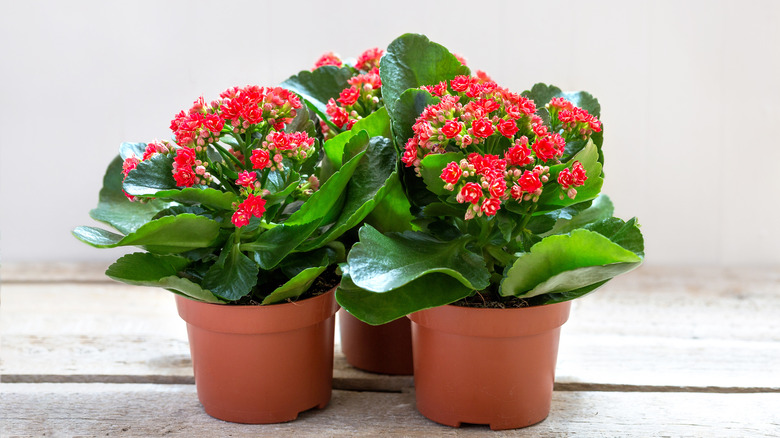20 Indoor Blooming Plants To Brighten Up Your Home
Houseplants are a great way to spruce up your home, adding color, texture, vibrancy, and life. They are also a great hobby, especially for those with a green thumb and no time to garden. One of the ultimate tasks of houseplant enthusiasts is getting a flowering plant to produce blooms, and while some are easier than others, it is still a gratifying task.
Blooming houseplants also provide a lot more color and visual variation than regular green plants. In addition, they can produce lovely scents to enhance the environment of your home. Not only this, but according to Focus Manifesto, there are other health and personal benefits to blooming plants, such as reducing stress, increasing air quality, improving productivity, and boosting the immune system. Keep reading for inspiration and ideas if you want to incorporate a blooming plant into your home but don't know where to start or what expertise is required.
1. Peace lily
Peace lilies are one of the easiest flowering houseplants to get to bloom. According to Gardening Know How, they are also great air-purifying plants and extremely easy to care for. Peace lilies generally require medium to low light, semi-regular watering on the conservative side, and biannual fertilizing. You can find these plants easily, are usually relatively inexpensive at a local garden center, and will grow tall and full by simply requiring minimal care needs.
2. Clivia
Clivia is a very unique flowering houseplant, growing leaves in dark green, arched, almost spider leg-shaped fronds, and flowers with beautiful orange blooms and a yellow center. As per Gardening Know How, clivia can be left outside in the warm months, brought inside for the winter, or kept indoors year-round. They require bright, indirect light when indoors and should be left to slightly dry in between watering. To encourage blooms, keep them pot-bound, and only water to keep them alive for the three months following late October. They should bloom in early spring.
3. Bromeliad
Bromeliads are another popular and easy-to-bloom houseplant. They produce bright red, orange, or pink flower spathes among waxy green foliage. However, they do require a little more finessing than a simple peace lily. According to Bromeliad.info, these plants prefer to be drier than wet and can withstand drought more than being over-watered. They also like to be kept at 60% humidity, which you can provide with regular misting, a humidifier, or a pebble tray. Bromeliads will have a more vibrant bloom when kept in bright, indirect light.
4. Zebra plant
Zebra plants can refer to various flora with striped coloration, but the Aphelandra squarrosa is the only one of these varieties that produce flowers. This zebra plant is among the trickier houseplants but very worthwhile. When its needs are met, it produces lush dark green leaves with silver striping and bright yellow flowers. House Plants Expert mentions this plant needs bright, indirect light, 60% to 70% humidity, and regularly moist but not soggy soil.
5. African violet
African violets are prominent among the houseplant community. They are absolutely gorgeous, producing low and dense flowers in purple, pink, and white, but require a lot of care and dedication. According to The Spruce, African violets prefer bright, indirect sunlight, but many find they grow best a foot under fluorescent plant lights. They like to be kept moist with warm water but not wet. Therefore, they should not be in humidity levels lower than 60% or higher than 70% and should also be fed with an African violet fertilizer regularly.
6. Anthurium
Anthuriums are an incredibly popular blooming houseplant, growing tall with simple but beautiful green foliage and stunningly vibrant spathes in red and hot pink shades. They are a little difficult to care for but not nearly as tricky as other blooming plants. According to Gardening Know How, they will bloom best in bright, indirect light and prefer to dry out completely between watering, as they are susceptible to root rot. To encourage blooms, fertilize with a high phosphorus fertilizer diluted to quarter strength once every three months.
7. Chrysanthemums
Most people are familiar with chrysanthemums; seeing them dot on front porches announces the fall season. However, they don't have to be limited to seasonal decor and can actually be grown indoors. That being said, they are not likely to re-bloom after their initial flowering, and for that reason, many people choose to throw them out or compost them after their first blooms die. According to Gardening Know How, chrysanthemums prefer bright, indirect light, frequent bottom watering, low humidity, and good air circulation.
8. Silver vase plant
The silver vase plant is a variety of bromeliad, also commonly known as the urn plant. They are visually unique from a typical bromeliad because of their silvery film variegation and muted but still bright, pink spathe. According to House Plants Expert, the silver vase plant prefers bright, indirect light and semi-frequent watering. However, they have to dry out completely between watering, need average humidity, and monthly feeding with a diluted liquid houseplant fertilizer during the growing season.
9. Christmas cactus
Christmas cacti produce indoor blooms, but they are tricky to grow. This plant is a popular choice for people wanting to tackle a blooming cactus, which blooms in tiny red or pink flowers on the end of its spiky leaves. Larger and older plants tend to trail down, too. According to Almanac, this cactus prefers bright, indirect light, to be kept more on the humid side (such as that of a bathroom), and should only be watered when the top third layer of the soil is completely dried out.
10. Angel wing begonia
Angel wing begonias are a great and popular outdoor plant, but their delicate, paper-thin, bright pink flowers can be enjoyed indoors, too. They have a tendency to trail and droop, making them a gorgeous view in a hanging basket or on a tall shelf left to trail. Houseplant 411 recommends providing this plant with bright, indirect light, slightly moist soil (tending to the drier side), high humidity, and biweekly feeding with a high phosphorus fertilizer during blooming season.
11. Geranium
Geraniums are a popular outdoor plant for landscaping and bold flower gardens, but you can also enjoy the dramatic exuberance of their blooms inside the house. There are even some scented variations of geraniums, which can help provide rooms in your home with a pleasant aroma. As for care, Gardening Know How recommends six to eight hours of direct light a day, letting the soil dry out completely between waterings, and either one slow-release fertilizer at the beginning of blooming season or monthly fertilizing with diluted liquid fertilizer.
12. Cyclamen
Cyclamen are interesting plants, producing dense and low foliage with silver variegation, thin purple stalks, and delicate cup-shaped pink leaves. They are great for ground cover outdoors, but they are equally great as a striking houseplant. Gardening Know How warns that this plant is delicate to both over and under-watering: Water when the surface is dry, but not any longer after. For anxious indoor gardeners, consider purchasing a moisture meter. To encourage re-blooming, let the plant's leaves and blooms die off, withhold watering for dormant months, and resume care in the spring.
13. Purple oxalis
Purple oxalis, also commonly referred to as purple shamrock or false shamrock, is a variation from the typical blooming houseplant, offering dark purple, almost black triangular leaves with tiny white and pink flowers. The Spruce says this plant prefers four hours of direct sun a day, placed next to a window with plenty of light. Water semi-regularly, taking more care not to let young plants dry out. Keep them away from drafty areas, open windows, and air vents during windy weather.
14. Jasmine
Many people love jasmine for its unique and calming scent, beauty, and herbal benefits. Jasmines do well indoors, filling your home with their particular aroma; however, Gardening Know How says they can also benefit from being relocated outside during summer. They prefer up to four hours of direct sunlight a day, such as that provided by a western or eastern window. They also like good air circulation, and their soil should be kept moist but not soggy.
15. Lavender
Lavender is another flowering plant loved for its delicate scent. It produces fuzzy green foliage with delicate purple, tubular flowers. Smart Garden Guide recommends exposing your indoor lavender to three to four hours a day of direct sunlight, low humidity, fertilizing twice a year, and watering only once the first inch of soil is completely dried out. If your variety is culinary grade, you can also include it in baking and cooking and even add it to your own herbs de Provence spice blend.
16. Gloxinia
Gloxinia is a very fun flowering houseplant, producing lush green foliage and thick, ruffled, brightly colored flowers. Some variations have a white stripe that outlines the flower, and some are just one color. According to Gardening Know How, they are also relatively easy to care for. They prefer bright, indirect sun and moist soil as they will go dormant if left to dry out. These plants also require biweekly feeding of high phosphorus fertilizer.
17. Roses
Roses don't have to be left to die in a vase of water to be enjoyed indoors. Gardening Know How says they need six to eight hours of direct light a day, such as the light provided by a southern or western facing window. They prefer good air circulation but avoid placing them near drafty areas. They also like a little humidity, as dry roses will attract spider mites. On that end, consider using a pebble tray and water when the top inch of soil is dry.
18. Crown of thorns
While the name and spiky base may suggest a thorny personality, the crown of thorns plant is relatively easy to care for as far as blooming plants go. According to The Spruce, this spiky succulent likes three to four hours of direct sun a day, preferring a western or southern window. Succulents do not need frequent watering, only when the top inch or so has completely dried out. Feed with a diluted liquid fertilizer every time you water during their blooming season.
19. Orchids
Orchid care can seem intimidating, as they are somewhat finicky plants, but their delicate petals and scent make it worth the effort. There are also many orchid-specific plant care products, taking out much of the trial and error. Gardening Know How says they prefer bright, indirect light; they won't bloom if deprived of light, but direct sunlight can damage leaves. They also like to be 15 or so degrees cooler at night than during the day to encourage better blooms. Let dry out between watering, and provide 50% to 70% humidity. Feed weekly during the blooming season.
20. Kalanchoe
Kalanchoe is a fascinating plant. It resembles a basic flowering houseplant, but it is actually a succulent with remarkably delicate flowers, which can come in white, red, pink, and yellow. According to The Spruce, they prefer bright, indirect light, but they need a period of six weeks to experience 14 hours of shade per day to increase blooms. This plant is drought-tolerant and prefers to dry out completely between watering. Feed once a month with liquid fertilizer or a high phosphorous one to encourage blooming.
